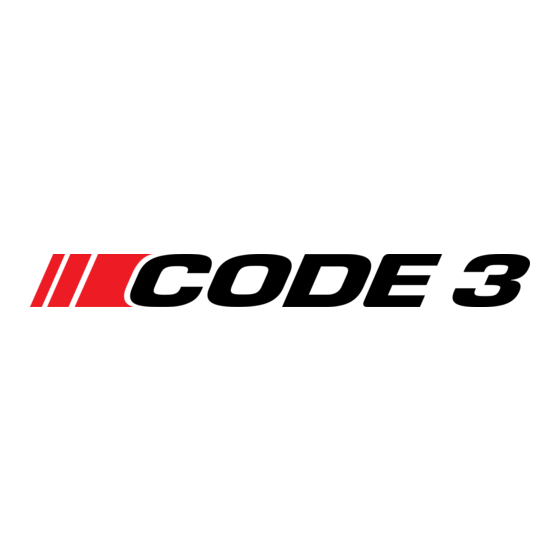Advertisement
IMPORTANT! Read all instructions before installing and using. Installer: This manual must be delivered to the end user.
WARNING!
Failure to install or use this product according to manufacturer's recommendations may result in property damage, serious injury, and/
or death to those you are seeking to protect!
Do not install and/or operate this safety product unless you have read and understood the safety information
contained in this manual.
1.
Proper installation combined with operator training in the use, care, and maintenance of emergency warning devices are essential to
ensure the safety of emergency personnel and the public.
2.
Emergency warning devices often require high electrical voltages and/or currents. Exercise caution when working with live electrical
connections.
3.
This product must be properly grounded. Inadequate grounding and/or shorting of electrical connections can cause high current arcing,
which can cause personal injury and/or severe vehicle damage, including fire.
4.
Proper placement and installation is vital to the performance of this warning device. Install this product so that output performance of
the system is maximized and the controls are placed within convenient reach of the operator so that they can operate the system without
losing eye contact with the roadway.
5.
Do not install this product or route any wires in the deployment area of an air bag. Equipment mounted or located in an air bag
deployment area may reduce the effectiveness of the air bag or become a projectile that could cause serious personal injury or death.
Refer to the vehicle owner's manual for the air bag deployment area. It is the responsibility of the user/operator to determine a suitable
mounting location ensuring the safety of all passengers inside the vehicle particularly avoiding areas of potential head impact.
6.
It is the responsibility of the vehicle operator to ensure daily that all features of this product work correctly. In use, the vehicle operator
should ensure the projection of the warning signal is not blocked by vehicle components (i.e., open trunks or compartment doors),
people, vehicles or other obstructions.
7.
The use of this or any other warning device does not ensure all drivers can or will observe or react to an emergency warning signal.
Never take the right-of-way for granted. It is the vehicle operator's responsibility to be sure they can proceed safely before entering an
intersection, drive against traffic, respond at a high rate of speed, or walk on or around traffic lanes.
8.
This equipment is intended for use by authorized personnel only. The user is responsible for understanding and obeying all laws
regarding emergency warning devices. Therefore, the user should check all applicable city, state, and federal laws and regulations. The
manufacturer assumes no liability for any loss resulting from the use of this warning device.
Specifications
Input Voltage:
12VDC
Input Current:
8A @ 12VDC Nominal (100W)
16A @ 12VDC Nominal (2 x 100W)
Standby Current:
<0.125mA
Fuse:
20A
Operating Frequency
Range:
125Hz - 1kHz
Output Power:
2 x 100W Max. (8Ω Speaker)
Temp. Range:
-40ºC - 65ºC
-40ºF - 149ºF
Installation and Operation Instructions
Low Frequency Speaker with Amplifier
WARNING!
Sirens produce loud sounds that may damage hearing.
• Wear hearing protection when testing
• Use siren only for emergency response
• Roll up windows when siren is operating
• Avoid exposure to the siren sound outside of vehicle
IMPORTANT WARNINGS TO USERS OF SIRENS: "Wail"
and "Yelp" tones are in some cases (such as the state of
California) the only recognized siren tones for calling for the
right of way. Ancillary tones such as "Air Horn", "Hi-Lo", "Hyper-
Yelp", and "Hyper-Lo" in some cases do not provide as high a
sound pressure level. It is recommended that these tones be used
in a secondary mode to alert motorists to the presence of multiple
emergency vehicles or to the momentary shift from the primary
tone as an indication of the imminent presence of any emergency
vehicle.
Page 1 of 5
Advertisement
Table of Contents

Summary of Contents for Code 3 LF-KIT1
- Page 1 Installation and Operation Instructions Low Frequency Speaker with Amplifier IMPORTANT! Read all instructions before installing and using. Installer: This manual must be delivered to the end user. WARNING! Failure to install or use this product according to manufacturer’s recommendations may result in property damage, serious injury, and/ or death to those you are seeking to protect! Do not install and/or operate this safety product unless you have read and understood the safety information contained in this manual.
- Page 2 Low Frequency Configuration Low Frequency Tone - The Low Frequency feature will only operate when the primary siren system is generating a tone. When there is a signal from a primary siren and the Low Frequency input is activated, the Low Frequency Siren can generate one of three Low Frequency tones.
-
Page 3: Installation And Mounting
Installation and Mounting The Low Frequency Amplifier may be mounted in the trunk or a console near the primary siren. There are four mounting slots on the Low Frequency Amplifier. All connections are made on one side of the siren. Mount the siren to allow for easy access to this side. All connections are made to the quick disconnect harness. - Page 4 WHITE +12V (+) ACTIVATION WHITE/ BLACK (-) ACTIVATION ORANGE/ BLACK FREQUENCY ORANGE SPEAKER(S) WIRE CAPACITY REQUIREMENTS FOR LOW FREQUENCY SIREN AMPLIFIER (INCOMING POWER) - EACH SUPPLY AND GROUND WIRE: Wire Length Minimun Wire Gauge 0 -10 FEET 14 AWG 12 AWG 10 -20 FEET 20-30 FEET 10 AWG...
-
Page 5: Warranty
*Code 3®, Inc. reserves the right to repair or replace at its discretion. Code 3®, Inc. assumes no responsibility or liability for expenses incurred for the removal and /or reinstallation of products requiring service and/or repair.;...







Need help?
Do you have a question about the LF-KIT1 and is the answer not in the manual?
Questions and answers